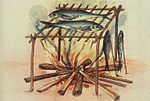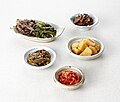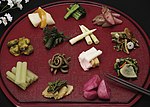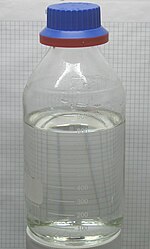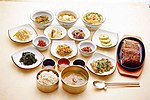Korean brining salt, also called Korean sea salt, is a variety of edible salt with a larger grain size compared to common kitchen salt. It is called gulgeun-sogeum...
3 KB (203 words) - 01:37, 4 June 2022
salt used for manufacturing pickles Korean brining salt – Coarse salt Pickling – Procedure of preserving food in brine or vinegar Curing (food preservation) –...
8 KB (851 words) - 11:45, 19 October 2024
paste known in Korea as doenjang. However, these claims are not substantiated by high-quality studies. Bath salts Brine mining History of salt Food portal...
14 KB (1,447 words) - 22:34, 28 October 2024
Kimchi (redirect from Korean Sauerkraut)
Kimchi (/ˈkɪmtʃiː/; Korean: 김치; RR: gimchi, IPA: [kim.tɕʰi]) is a traditional Korean side dish (banchan) consisting of salted and fermented vegetables...
99 KB (8,712 words) - 10:17, 29 October 2024
Baechu-kimchi (category CS1 uses Korean-language script (ko))
and more pungent. Korean brining salt, which has a larger grain size compared to common kitchen salt, is used for the initial salting of napa cabbages...
9 KB (721 words) - 18:18, 11 August 2024
Soy sauce (redirect from Korean soy sauce)
saltier than other Korean ganjang varieties, hansik ganjang is used mainly in guk (soup) and namul (seasoned vegetable dish) in modern Korean cuisine. Common...
74 KB (8,493 words) - 06:32, 31 October 2024
Cured fish (section Salt curing)
in brine and then smoked. Ceviche (Peru) - Fish or shellfish marinated and cured in citrus and seasonings Food portal Brining Charcuterie Curing salt List...
15 KB (1,689 words) - 11:51, 4 October 2024
List of edible salts (category Edible salt)
table salts, are salts generally derived from mining (rock salt) or evaporation (including sea salt). Edible salts may be identified by such characteristics...
16 KB (321 words) - 18:25, 25 August 2024
unpalatable food. Salting, brining, and pickling are also ancient and important methods of food preservation. Some of the earliest evidence of salt processing...
71 KB (7,459 words) - 18:35, 23 October 2024
which are in a solid state; in brine mining, the materials are already dissolved. Brines are important sources of common salt (NaCl), calcium, iodine, lithium...
35 KB (3,558 words) - 17:54, 23 June 2024
Surströmming (category Articles containing Korean-language text)
fish through fermentation in weak brine may have developed when brining was still expensive due to the cost of salt. In modern times, the fish are initially...
24 KB (2,631 words) - 10:27, 30 October 2024
fried cuttlefish might be cooked in green sambal chili paste. Brining Cantonese salted fish Cured fish Ojingeo-jeot Squid as food M. Sugiyama (1989)....
3 KB (273 words) - 18:31, 6 March 2024
or salt Pickled radish – Radish dish served with Korean fried chicken Pickling salt – Fine-grained salt used for manufacturing pickles Prawn – Crustaceans...
12 KB (1,508 words) - 05:44, 31 October 2024
Shallow frying Stir frying Brining –Brining is a process similar to marination in which meat or poultry is soaked in brine before cooking Ceviche Drying...
16 KB (1,605 words) - 04:49, 19 October 2024
moisture, a pickling brine may be produced simply by adding dry salt. For example, sauerkraut and Korean kimchi are produced by salting the vegetables to...
40 KB (4,378 words) - 06:28, 28 October 2024
Takuan (category Articles containing Korean-language text)
called danmuji (단무지) in Korea. Danmuji is a common banchan (side dish) served with bunsik (light meal or snack), as well as with Korean Chinese dishes. In...
5 KB (473 words) - 05:35, 28 October 2024
of differences in the type of fruit chosen and the composition of the brining solutions used, chamoy can vary widely in taste. Most are quite savory...
10 KB (1,147 words) - 02:28, 21 July 2024
Doenjang (category Articles with Korean-language sources (ko))
Doenjang (Korean: 된장; "thick sauce") or soybean paste is a type of fermented bean paste made entirely of soybean and brine used in Korean cuisine. It...
18 KB (1,752 words) - 06:39, 1 November 2024
Banchan (redirect from Korean side dish)
(/ˈbɑːntʃɑːn/ BAHN-chahn; Korean: 반찬; Hanja: 飯饌; IPA: [pantɕʰan]) are small side dishes served along with cooked rice in Korean cuisine. Banchan are often...
23 KB (2,126 words) - 21:37, 16 September 2024
Pickled cucumber (redirect from Pickle brine)
of the world. Brined pickles are prepared using the traditional process of natural fermentation in brine, making them grow sour. The salt concentration...
33 KB (3,111 words) - 14:37, 28 October 2024
Pa-kimchi (category Articles containing Korean-language text)
jjokpa (Korean: 쪽파), which are fermented to maturity in powdered red pepper gochutgaru, garlic, ginger and seasoned with myeolchi jeot (salted anchovies)...
3 KB (102 words) - 17:15, 20 October 2024
moisture out of the fish and into the salt and sugar, turning the dry mixture into a highly concentrated brine, which can be used in Scandinavian cooking...
5 KB (436 words) - 23:24, 4 September 2024
the resin bed. Brine draw: Water is directed through a jet pump, which pulls salt water from the brine tank, before the water and brine pass through the...
23 KB (2,625 words) - 12:05, 24 September 2024
preserved by pickling, which usually involves submersion in a brine of vinegar and salted water with herbs and spices, often including peppercorns, coriander...
10 KB (1,072 words) - 05:58, 14 August 2024
Soup soy sauce (category CS1 Korean-language sources (ko))
sauce or "guk-ganjang" (Korean: 국간장) is a type of Korean soy sauce (ganjang) made entirely of fermented soybeans (meju) and brine. It is also a byproduct...
11 KB (1,175 words) - 00:24, 11 March 2024
Petrolithium is lithium derived from petroleum brine, the mineral-rich salt solution that is brought to the surface during oil and gas production and exploration...
3 KB (276 words) - 16:34, 5 July 2024
"pickled things") are Japanese preserved vegetables (usually pickled in salt, brine, or a bed of rice bran). They are served with rice as an okazu (side...
7 KB (674 words) - 01:29, 16 June 2024
Hydrochloric acid (redirect from Spirit of salt)
Korean: 염산 (yeomsan). Gaseous HCl was called marine acid air. The name muriatic acid has the same origin (muriatic means "pertaining to brine or salt"...
38 KB (3,993 words) - 11:43, 21 October 2024
seafood and (at least in South Korea) meats. Dairy is largely absent from the traditional Korean diet. Traditional Korean meals are named for the number...
110 KB (13,181 words) - 23:06, 16 October 2024
2024. "Click Korea: Access to Korean Arts & Culture". Archived from the original on 19 July 2011. Retrieved 22 March 2010. 오리탕 (in Korean). Doosan Encyclopedia...
35 KB (3,404 words) - 01:36, 19 August 2024







